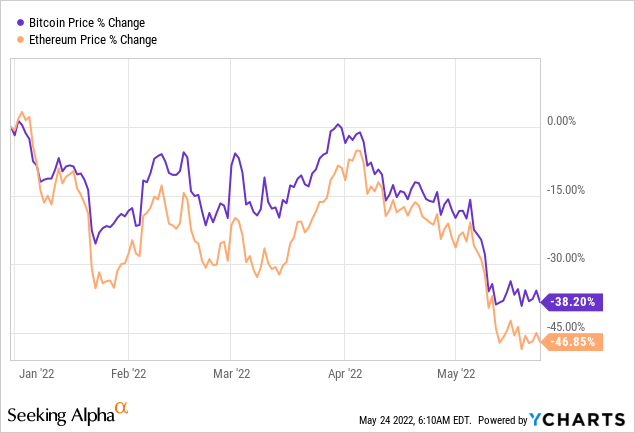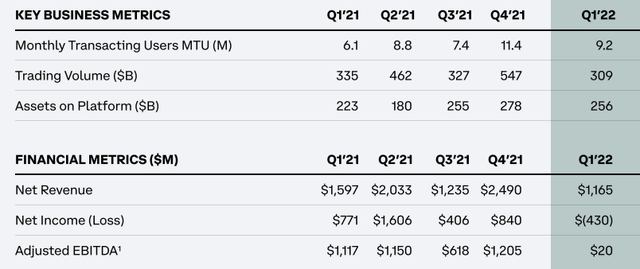
Images we create and what actually happens are always beautiful when we have imagination./iStock Editorial via Getty Images
For as long as I can remember, I have been bullish on the prospects for cryptocurrencies. No, this does not mean that I invested in Bitcoin (BTC-USD), and that is because I found no conclusive evidence to believe one cryptocurrency is better than another. I was excited when Coinbase Global, Inc. (NASDAQ:COIN) went public last year because investing in Coinbase would indirectly expose me to the crypto industry without having to bear the risks associated with individual tokens. I found Coinbase attractive even at its IPO price, but the hype around cryptocurrencies and digital assets in 2021 prompted me to remain on the sidelines to see whether the enthusiasm would fade, giving investors a better opportunity to invest in the crypto sector. With crypto prices down substantially since the beginning of the year, it seems a good time to evaluate the long-term prospects for Coinbase Global.
Why Is Cryptocurrency Falling?
Following the release of the Labor Department’s monthly consumer price index report, which revealed that inflation exceeded expectations, Bitcoin’s price dipped below $30,000 on May 12 to its lowest level since December 2020. The Federal Reserve’s intention to boost interest rates through 2023 to combat growing inflation has fueled fears of an impending recession. As a result, the market witnessed an increased sell-off of risky assets, and cryptocurrencies got hammered in the process.
Rising prices and a bleak economic outlook are causing investors to sell out of cryptocurrencies and other highly volatile assets. Bitcoin plummeted below $26,000 briefly amid a larger cryptocurrency sell-off that saw the market lose almost $200 billion in a single day. Ethereum (ETH-USD), the second most popular digital currency, fell below $2,000 as well. The decline was exacerbated by the collapse of TerraUSD (UST-USD) stablecoin. UST is an algorithmic stablecoin backed by code and reportedly pegged to the dollar at 1:1. UST could always be exchanged for $1 worth of Terra (LUNA-USD), a sister coin on the same blockchain with a floating price that was designed to absorb UST price shocks. However, on May 10, the stablecoin began to lose its peg, sparking a frantic sell-off as holders hurried to unload LUNA, wiping off 99% of its value and pushing UST below $1.
Exhibit 1: YTD performance of Bitcoin and Ethereum

In addition to recession fears and the collapse of TerraUSD, regulatory pressures and the volatility in capital markets have also played a part in the decline in cryptocurrency prices this year.
How Is Coinbase Stock Impacted By Cryptocurrency?
An investor only has to look at the Q1 financial performance of Coinbase to gauge a measure of the correlation between the company’s fortunes and the strength in the cryptocurrency market.
Lower trading volume and a weak market for cryptocurrencies resulted in a 36% YoY drop in revenue for Coinbase in the first quarter. The company posted a worse-than-expected loss of $430 million in the first quarter, compared to a profit of $771 million in the comparable quarter last year. The majority of Coinbase’s revenue comes from trading fees, which fell due to falling crypto prices and volatility that began in 2021, driving trade volume down to $309 billion, down 8% year-over-year and 44% sequentially. The number of retail monthly transacting users fell 19.3% QoQ to 9.2 million. The company expects further declines in monthly transacting users and trading volume, as well as subscription and service revenue, in the coming quarter.
Exhibit 2: Q1 key metrics

Shareholder letter
Source: Q1 shareholder letter
Coinbase’s quarterly financial filing with the Securities and Exchange Commission, which cautioned about bankruptcy risks, led to additional worries for investors. Coinbase disclosed how it holds customer assets and what would happen if it were to go bankrupt. The company stated that in the case of a bankruptcy, crypto-assets it holds in custody on behalf of its customers could be subject to bankruptcy procedures, and those customers could be classed as unsecured creditors in general. This means that customers would be unable to access funds if Coinbase goes bankrupt. Although Coinbase CEO Brian Armstrong tried to reassure customers by saying that their funds are safe at Coinbase and that the company is not in danger of going bankrupt, it goes without saying that failing to safeguard and manage customers’ fiat currencies and crypto assets could harm the company’s operations and financial results. As crypto-assets are not insured or guaranteed by any government institution, the company’s business relies on internal controls to protect assets, as well as public faith in its competence to appropriately manage customer funds.
Some investors are beginning to realize for the first time that their crypto assets differ from other investments as these digital assets are not backed by a regulator, which makes holding cryptocurrencies riskier during times of economic turbulence. One of crypto’s major strengths – regulatory independence – is proving to be an obstacle to Coinbase’s short-term profitability.
What Is The Future Price Of Coinbase Stock?
Volatility is not the same as risk. There are a lot of risks associated with investing in cryptocurrencies and Coinbase stock, but volatility should not be considered one. Volatility is part of the long-term price cycles of cryptocurrencies, and it will have an impact on Coinbase as it is one of the largest operators of digital assets in the world. The company is actively investing to diversify its business away from volatile trading and there is more room for the company to grow with the expanding digital economy and the wide adoption of digital currencies. There are several reasons why COIN stock appears to be a bargain today.
Even though transaction fees make for the majority of the company’s revenue (87%), Coinbase aims to expand the usage of crypto and digital assets as a financial system. Coinbase is focused on growing as a service provider that offers similar functions to a digital wallet and mobile payment service with the only difference being transacting in crypto assets instead of fiat currencies. Because the company offers attractive security features that are considered industry-leading and cryptocurrencies traded on its platform are insured against online security breaches, we believe consumers will adopt crypto payment services introduced by Coinbase along with the growing recognition of cryptos among regulators.
Coinbase currently earns the majority of its revenue from fees charged to users who buy and sell digital assets on the platform. However, in recent quarters, the company has focused on diversifying into more stable recurring revenue streams such as providing businesses with access to its Coinbase Cloud computing solution, crypto staking, custodial digital wallets, payment services including its new debit card, and an NFT marketplace. Despite the lackluster growth in the recent quarter on the revenue front, diversification is likely to boost the company’s future earnings potential resulting from the steady growth of MTUs. Coinbase will attract a wide range of users in the long run – not just traders who are looking to make some quick money by flipping cryptocurrencies.
For now, Coinbase stock is very likely to follow the moves in the cryptocurrency market, in particular the likes of Bitcoin. In the long run, however, I believe COIN stock will detach from crypto prices as the company builds on its recurring revenue streams and the subscription business. This transition will allow Coinbase stock to follow its earnings, and this is when early investors are likely to see handsome returns. For this to happen, the blockchain economy should evolve from its current state where cryptocurrency trading has taken the center stage to an advanced state where blockchain technology plays an integral role in the global economy.
Exhibit 3: The evolution of the blockchain economy
For the blockchain economy to evolve to a more mature stage, it will take time. Even in the best-case scenario, we need to look ahead for at least 5 years from now, meaning it would take patience and a strong stomach to weather short-term volatility in stock prices until things turn for the better. Because of the substantial volatility in business conditions, it seems futile to assign an intrinsic value estimate for Coinbase as cryptocurrency prices are difficult to predict. In the long run (5 years+), Coinbase stock should trade considerably higher than current market prices given the massive runway for growth as an enabler of the blockchain economy.
Investments Will Cost Profits
A closer look at Coinbase’s financials reveals that costs are rising, which might not be an encouraging sign for many investors. Although Coinbase reported a loss of $430 million for Q1 on trading volume of $309 billion, MTUs of 9.2 million, and total assets of $256 billion, the company has previously been profitable or performed much better at similar business and financial metrics levels (for example, in Q3 2021). This observation suggests Coinbase’s cost base has increased. However, one of the biggest contributors to this increase has been investments in the business to build the necessary IT infrastructure to support advanced solutions to users. Although these investments will be a drag on short-term profitability, these investments are necessary to secure the sustainability of long-run earnings.
Takeaway
Coinbase stock remains under pressure along with cryptocurrencies. The short-term volatility in stock prices, however, offers long-term-oriented investors an opportunity to double down on Coinbase stock. There are a lot of moving parts, but Coinbase seems well-positioned to grow in the long run, which should convert into higher stock prices.




